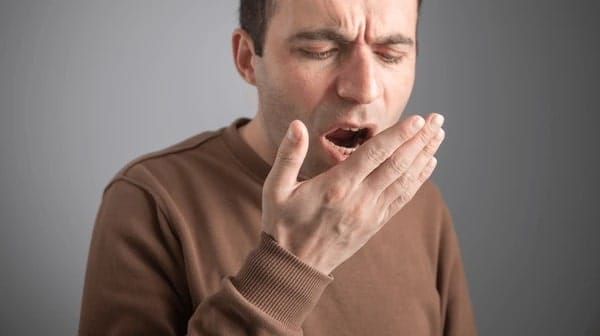When people talk about dental implant bad breath, they usually mean a persistent, unpleasant odour that seems to come from the area around an implant-supported crown or bridge. While titanium itself is inert (so a titanium dental implant odour isn’t coming from the metal), smells can arise from soft tissues and biofilm around the implant abutment, from trapped food debris under the crown margin, or from gum inflammation. In everyday terms: the implant doesn’t create halitosis; the environment around it sometimes does.
Can implants themselves cause halitosis after implant surgery?
Short answer: not directly. However, halitosis after implant surgery can occur during the early healing phase because tissues are remodelling and plaque control can be trickier. A mild post-implant healing smell can be temporary. If odour lingers, though, it may indicate plaque accumulation, bacteria around the implant abutment, or early gum irritation that needs attention.
What usually drives odour around implants?
Several well-known, cause-related attributes can lead to odour near implants:
- Peri-implantitis or peri-implant mucositis (gum inflammation around dental implants)
- Poor oral hygiene (biofilm build-up due to inadequate cleaning)
- Crown fit issues that trap food debris
- Smoking and dry mouth (reduced saliva flow)
- History of gum disease or diabetes (risk factors for inflammation)
Possible causes of bad breath from dental implants
- Peri-implantitis – gum infection around the implant post.
- Poor oral hygiene – plaque and food debris accumulating around implant crowns.
- Crown fit issues – gaps that trap bacteria.
- Smoking – reduces blood flow and promotes bacterial growth.
- Dry mouth – saliva reduction leading to odour.
- Healing phase bacteria – temporary odour during early recovery.
Which symptoms suggest a problem rather than normal healing?
Symptom-related attributes to watch for include unpleasant odour, bad taste, bleeding gums, swelling around the implant, and discomfort when chewing. These can signal infection around a dental implant or a biofilm management gap that needs professional evaluation.
How do crown design and fit contribute to implant-supported crown odour?
Even a beautifully placed implant can develop odour if the implant crown cleaning access is poor. Overhanging margins or deep, narrow embrasures can make it harder to remove plaque. That doesn’t mean your restoration is faulty; it means your cleaning strategy must be tailored—sometimes with interdental brushes sized to your spaces, or a water flosser to flush under a bridge pontic. Your clinician may also assess whether small adjustments or a new contour would reduce plaque stagnation.
Who is most at risk of implant-related odour?
Risk-factor attributes include smoking, diabetes, poor oral hygiene habits, and a history of gum disease. A dry mouth and implants combination increases risk too, because saliva buffers acids and mechanically helps clear bacteria. Medications, dehydration, and mouth breathing can all reduce saliva and make dental biofilm management tougher.
How should you clean implant-supported crowns and bridges?
“Set and forget” doesn’t work with implants. A focused dental implant maintenance routine is essential:
- Brush twice daily with a soft-bristled brush focusing on the gumline.
- Use interdental brushes or superfloss around the implant abutment and under connectors.
- Consider a water flosser to dislodge food debris in implants and under bridgework.
- Use an evidence-based antimicrobial mouthwash if your clinician recommends it as part of biofilm control.
- Attend regular professional cleanings and review visits for long-term implant care.
What daily prevention routine keeps bacteria around the implant abutment in check?
Prevention-related attributes revolve around meticulous home care and routine professional maintenance:
- Targeted brushing of crown margins and the peri-implant gumline
- Interdental cleaning matched to the embrasure size
- Professional reviews to monitor tissue health and long-term implant care
- Lifestyle tweaks that support saliva (e.g., adequate hydration)
- Avoiding smoking to improve tissue resistance
When should you book a dental review?
If any of the following warning signs show up, arrange an appointment promptly:
- Persistent bad breath despite good home care
- Swelling or redness around the implant
- Loose implant or crown
- Pus discharge from the gum
- Pain or tenderness in the implant area
What does the evidence say about peri-implantitis and odour?
Research consistently links peri-implantitis (a plaque-driven inflammatory disease) with deeper pockets, bleeding on probing, and bone loss around implants. These conditions often coexist with volatile sulphur-producing bacteria—the same broad microbiological patterns implicated in classic halitosis. Studies in the periodontal and implant literature emphasise that routine dental implant check-ups, professional debridement, and patient-specific hygiene instruction reduce complications and help control odour over the timeframe from early healing to the long term.
How do early-healing and long-term issues differ?
Implant Bad Breath – Early vs. Long-Term Issues
| Timeframe | Common Cause | Treatment |
| Early phase (first weeks) | Healing tissue odour, temporary bacterial growth | Gentle cleaning, follow post-op instructions |
| Long-term phase | Gum disease, crown issues, poor hygiene | Professional cleaning, possible implant adjustment, treat gum infection |
What’s the quick comparison of causes and prevention?
Causes vs. Prevention
| Cause | Description | Prevention |
| Peri-implantitis | Inflammation/infection of gum tissue around implant | Maintain proper cleaning, attend regular check-ups |
| Poor hygiene | Plaque & food accumulation | Brush, floss, use interdental aids |
| Dry mouth | Reduced saliva flow | Stay hydrated, avoid alcohol-based mouthwash |
| Crown fit issues | Gaps trapping bacteria | Dentist check for fit adjustments |
| Smoking | Impaired healing & bacterial growth | Quit or reduce smoking |
How do professional treatments address persistent odour?
Treatment-related attributes used by dental professionals include:
- Professional cleaning and implant debridement to disrupt mature biofilm
- Targeted antimicrobial adjuncts when clinically indicated
- Replacing or refining faulty crowns if margins trap plaque
- Antibiotics only when prescribed for specific infections after a clinical diagnosis
These measures focus on the root cause—biofilm and inflammation—rather than masking odour.
Why choose Palm Beach Dental for long-term implant care?
Implants deserve the same attention you’d give to any precision-engineered investment. At Palm Beach Dental, we take a thorough, prevention-first approach to oral hygiene for implants and implant-supported restorations. Expect individualised biofilm management, careful assessment of implant crown cleaning access, and clear guidance on the dental implant maintenance routine that fits your mouth—not a generic handout. Our clinicians monitor the soft tissues for early signs of gum inflammation around dental implants, refine restoration contours when needed to reduce plaque stagnation, and schedule review intervals that match your risk factors (such as smoking, diabetes, or history of gum disease). If odour crops up, we work methodically to identify whether it’s an early healing issue, a home-care gap, or something more complex like peri-implantitis—and we manage it decisively so your implant-supported crown odour doesn’t become a long-term problem.
Important FAQs
Q1) Do dental implants themselves smell?
No. Titanium and modern implant materials are inert. Odour arises from bacteria around the implant abutment or trapped food debris near the crown margins.
Q2) Is bad breath normal right after implant surgery?
A mild post-implant healing smell can occur for a short timeframe while tissues heal and cleaning is cautious. If odour persists or is accompanied by bleeding, swelling, or pain, book a review.
Q3) What is peri-implantitis and why does it matter for odour?
Peri-implantitis is a plaque-associated inflammation of tissues around an implant that can lead to bone loss. The same biofilm responsible for tissue inflammation can produce volatile sulphur compounds linked with halitosis.
Q4) How should I clean around an implant-supported bridge?
Use interdental brushes or superfloss under the connector and along the gumline, and consider a water flosser. Ask your clinician to size the brushes correctly so you can clean efficiently without trauma.
Q5) Which risk factors make implant odour more likely?
Smoking, dry mouth, diabetes, poor oral hygiene habits, and a history of gum disease raise the risk of inflammation and odour around implants.
Q6) What professional treatments fix persistent implant-related bad breath?
Clinicians may perform professional cleaning/implant debridement, refine the crown contour or margins, recommend antimicrobial adjuncts where indicated, and treat any infection around the dental implant according to diagnosis.
References
- Healthdirect Australia. Bad breath (halitosis): https://www.healthdirect.gov.au/bad-breath
- Healthdirect Australia. Dental implants: https://www.healthdirect.gov.au/dental-implants
- Australian Dental Association (teeth.org.au). Dental implants (consumer information): https://www.teeth.org.au/dental-implants
- Australian Dental Journal. Peri-implant diseases: a review of diagnosis and risk indicators (journal overview site): https://onlinelibrary.wiley.com/journal/18347819
- University-affiliated consumer summary on peri-implantitis (general overview, AU context): https://www.teeth.org.au/peri-implant-diseases



